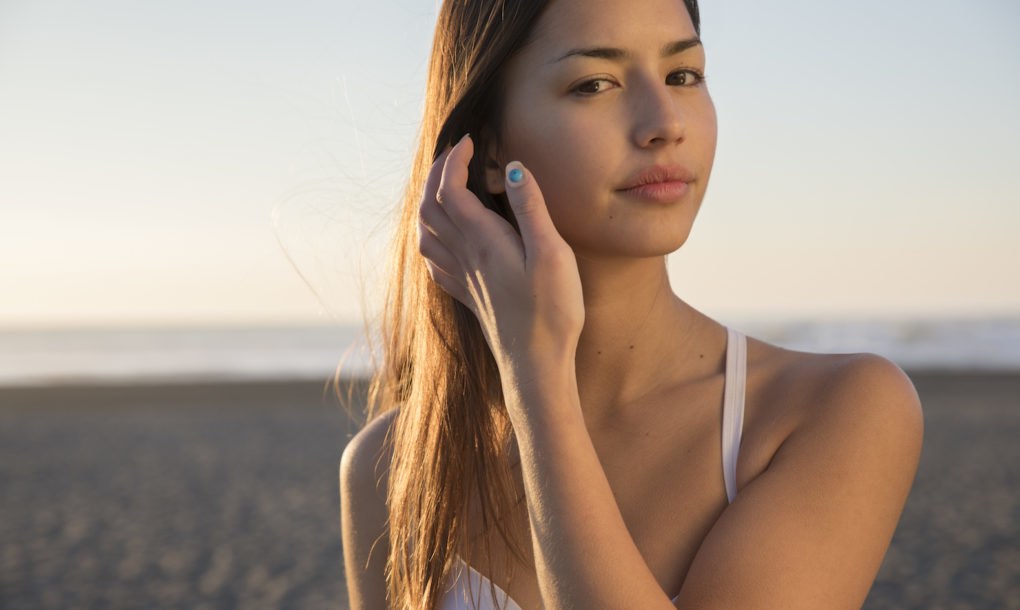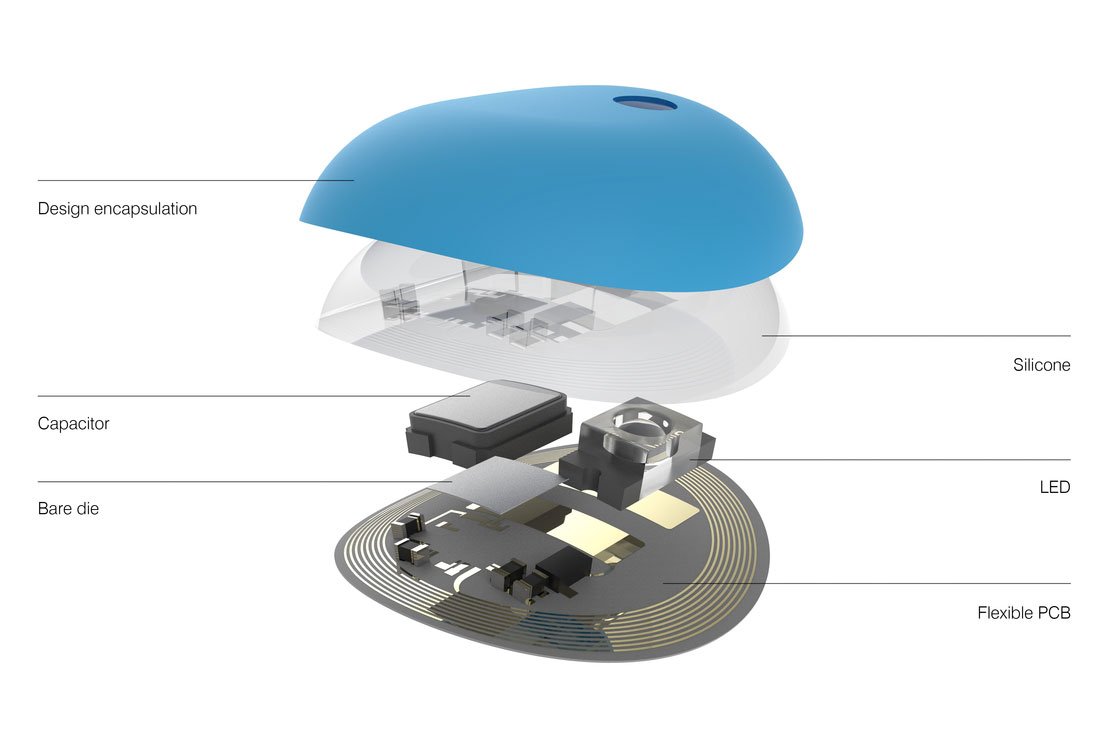You don’t (well, I don’t) expect a cosmetics company such as L’Oréal to introduce products at the Consumer Electronics Show (CES) held in Las Vegas (Nevada, US) annually (Jan. 6 – 9, 2016).
A Jan. 6, 2016 article by Zoe Kleinman for BBC (British Broadcasting Corporation) news online explains,
Beauty giant L’Oreal has unveiled a smart skin patch that can track the skin’s exposure to harmful UV rays at the technology show CES in Las Vegas.
The product will be launched in 16 countries including the UK this summer, and will be available for free [emphasis mine].
It contains a photosensitive blue dye, which changes colour when exposed to ultraviolet light.
But the wearer must take a photo of it and then upload it to an app to see the results.
It’s a free app, eh? A cynic might suggest that the company will be getting free data in return.
A Jan. 6, 2016 L’Oréal press release, also on PR Newswire, provides more details (Note: Links have been removed),
Today [Jan. 6, 2016] at the Consumer Electronics Show, L’Oréal unveiled My UV Patch, the first-ever stretchable skin sensor designed to monitor UV exposure and help consumers educate themselves about sun protection. The new technology arrives at a time when sun exposure has become a major health issue, with 90% of nonmelanoma skin cancers being associated with exposure to ultraviolet (UV) radiation from sun* in addition to attributing to skin pigmentation and photoaging.
To address these growing concerns, L’Oréal Group’s leading dermatological skincare brand, La Roche-Posay, is introducing a first-of-its kind stretchable electronic, My UV Patch. The patch is a transparent adhesive that, unlike the rigid wearables currently on the market, stretches and adheres directly to any area of skin that consumers want to monitor. Measuring approximately one square inch in area and 50 micrometers thick – half the thickness of an average strand of hair – the patch contains photosensitive dyes that factor in the baseline skin tone and change colors when exposed to UV rays to indicate varying levels of sun exposure.
Consumers will be able to take a photo of the patch and upload it to the La Roche-Posay My UV Patch mobile app, which analyzes the varying photosensitive dye squares to determine the amount of UV exposure the wearer has received. The My UV Patch mobile app will be available on both iOS and Android, incorporating Near Field Communications (NFC)-enabled technology into the patch-scanning process for Android. My UV Patch is expected to be made available to consumers later this year.
“Connected technologies have the potential to completely disrupt how we monitor the skin’s exposure to various external factors, including UV,” says Guive Balooch, Global Vice President of L’Oréal’s Technology Incubator. “Previous technologies could only tell users the amount of potential sun exposure they were receiving per hour while wearing a rigid, non-stretchable device. The key was to design a sensor that was thin, comfortable and virtually weightless so people would actually want to wear it. We’re excited to be the first beauty company entering the stretchable electronics field and to explore the many potential applications for this technology within our industry and beyond.”
My UV Patch was developed by L’Oréal’s U.S.-based Technology Incubator, a business division dedicated entirely to technological innovation, alongside MC10, Inc., a leading stretchable electronics company using cutting-edge innovation to create the most intelligent, stretchable systems for biometric healthcare analytics. L’Oréal also worked with PCH who design engineered the sensor. The stretchable, peel-and-stick wearable unites L’Oréal Group’s extensive scientific research on the skin and expertise with UV protection with MC10’s strong technological capabilities in physiological sensing and pattern recognition algorithms to measure skin changes over time, and PCH’s 20-year experience in product development, manufacturing and supply chain.
“With My UV Patch, L’Oréal is taking the lead in developing the next generation of smart skincare technology powered by MC10’s unique, stretchable electronics platform, that truly addresses a consumer need,” said Scott Pomerantz, CEO of MC10. “This partnership with L’Oréal marks an exciting new milestone for MC10 and underscores the intersection of tech and beauty and the boundless potential of connected devices within the beauty market.”
*Source: Skin Cancer Foundation 2015
“Together with La Roche-Posay dermatologists like myself, we share a mission to help increase sun safe behavior,” added Alysa Herman, MD. “La Roche-Posay recently commissioned a global study in 23 countries, which surveyed 19,000 women and men and found a huge gap in consumer behavior: even though 92% were aware that unprotected sun exposure can cause health problems, only 26% of Americans protect themselves all year round, whatever the season. With the new My UV Patch, for the first time, we are leveraging technology to help incite a true behavioral change through real-time knowledge. ”
About L’Oréal
L’Oréal has devoted itself to beauty for over 105 years. With its unique international portfolio of 32 diverse and complementary brands, the Group generated sales amounting to 22.5 billion euros in 2014 and employs 78,600 people worldwide. As the world’s leading beauty company, L’Oréal is present across all distribution networks: mass market, department stores, pharmacies and drugstores, hair salons, travel retail and branded retail.
Research and innovation, and a dedicated research team of 3,700 people, are at the core of L’Oréal’s strategy, working to meet beauty aspirations all over the world and attract one billion new consumers in the years to come. L’Oréal’s new sustainability commitment for 2020 “Sharing Beauty With All” sets out ambitious sustainable development objectives across the Group’s value chain. www.loreal.com
About LA ROCHE-POSAY and ANTHELIOS
Recommended by more than 25,000 dermatologists worldwide, La Roche-Posay offers a unique range of daily skincare developed with dermatologists to meet their standards in efficacy, tolerance and elegant textures for increased compliance. The products, which are developed using a strict formulation charter, include a minimal number of ingredients to reduce side effects and reactivity and are formulated with effective ingredients at optimal concentrations for increased efficacy. Additionally, La Roche-Posay products undergo stringent clinical testing to guarantee efficacy and safety, even on sensitive skin.
About MC10
MC10’s mission is to improve human health through digital healthcare solutions. The company combines its proprietary ultra-thin, stretchable body-worn sensors with advanced analytics to unlock health insights from physiological data. MC10 partners with healthcare organizations and researchers to advance medical knowledge and create monitoring and diagnostic solutions for patients and physicians. Backed by a strong syndicate of financial and strategic investors, MC10 has received widespread recognition for its innovative technology, including being named a 2014 CES Innovation in Design Honoree. MC10 is headquartered in Lexington, MA. Visit MC10 online at www.mc10inc.com.
About PCH
PCH designs custom product solutions for startups and Fortune 500 companies. Whether design engineering and development, manufacturing and fulfilment, distribution or retail, PCH takes on the toughest challenges. If it can be imagined, it can be made. At PCH, we make. www.pchintl.com. Twitter: @PCH_Intl
Ryan O’Hare’s Jan. 6, 2016 article for the UK’s DailyMailOnline provides some additional technology details and offers images of the proposed patch, not reproduced here, (Note: A link has been removed),
…
The patch and free app, which will be launched in the summer, have been welcomed by experts.
Dr Christopher Rowland Payne, consultant dermatologist to The London Clinic, said: ‘This is an exciting device that will motivate people in a positive way to take control of their sun exposure and will encourage them to know when it is time to leave the sun or to reapply their sunscreen.
‘It is an ingenious way of giving people the information they need. I hope it will also get people talking to each other about safe sun exposure.’
…
The technology used in the UV patches is based on ‘biostamps’ designed by tech firm MC10.
They were originally designed to help medical teams measure the health of their patients either remotely, or without the need for large expensive machinery.
Motorola were exploring the patches as an alternative to using traditional passwords for security and access to devices.
…
Getting back to this ‘free app’ business, the data gathered could be used to help the company create future skincare products. If they are planning to harvest your data, there’s nothing inherently wrong with the practice but the company isn’t being as straightforward as it could be. In any event, you may want to take a good at the user agreement and decide for yourself.
Finally, I think it’s time to acknowledge medical writer, Dr. Susan Baxter, (not for the first time and not the last either) as I likely wouldn’t have thought past my general cynicism about data harvesting for a reason, additional to any humanitarian motivations L’Oréal might have, for offering a free mobile app. She doesn’t post on her blog that frequently but it’s always worth taking a look (http://www.susanbaxter.ca/blog-page/) and I recommend this July 30, 2014 post titled, ‘Civil Scientific Discourse RIP’ which focuses on vaccination and anti-vaccination positions. Do not expect a comfortable read.

